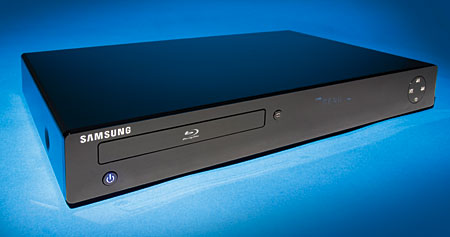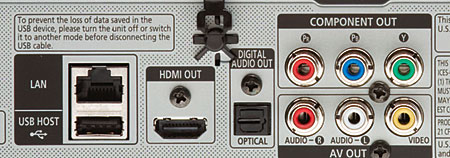I see common picture freezing.......even new never used DVD.'s...called Denon...so far...they have no clue how to fix it.
Shades of Blu Samsung BD-P1500
Samsung continues to show strong support for the Blu-ray format with another addition to its player lineup. Originally, Samsung designed the BD-P1500 ($399) with a few features that didn’t make it into the final model. However, Samsung still delivers a well-rounded package. The BD-P1500 includes bitstream output of the next-gen lossless audio formats, Bonus View PiP compliance, and (according to Samsung) the promise of future upgradeability to BD-Live.

The BD-P1500 is a streamlined player with an attractive gloss-black front panel that’s nearly devoid of any logos, acronyms, or markings. The exterior includes a simple user interface on the right side and a disc tray on the left. The lighting on the front-panel display is an attractive shade of blue, but it’s very bright, and I was disappointed I couldn’t turn it off during use.

The back panel doesn’t include as many connections as some of the other Blu-ray players on the market. But it hits the high points with support for HDMI 1.3a, Internet connectivity (currently only for software updates), and a USB input (for system updates and external storage). Samsung limited the analog audio outputs to two channels, so this isn’t a viable option if you’re planning to use analog connections.
 Video
Video
The BD-P1500 did a great job with 1080p/24 Blu-ray playback. It presented the high-quality image that we expect from Blu-ray players. The player resolves 1080p signals at full resolution and supports 1080p/24 playback. Since Samsung doesn’t use a high-end video processor, the BD-P1500 lacks the ability to properly convert 1080i to 1080p, regardless of the cadence. This only affects a limited number of titles on the market today (mostly concert videos), but it is still something you should consider if you’re looking for a complete high-performance Blu-ray solution.
The BD-P1500 did have an anomaly that I haven’t seen on any other Blu-ray player. For some reason, the menus looked slightly blurry. I noticed this almost immediately when I popped in my standard Blu-ray test disc that loads right to the menu screen. When I put in other Blu-ray releases, I saw the same thing. Letters lacked their usual sharpness, and menus exhibited a bit of haze and lack of contrast. While this didn’t affect movie playback, it still became a distracting oddity. When I moved on to standard DVD menus, I noticed that the highlighting function somehow shifted to the left of my intended selection.
Standard DVD video performed far better than I expected. Most Blu-ray players offer mediocre DVD performance compared with the better DVD players on the market. But the BD-P1500 performed remarkably well with my testing. It offered high-end deinterlacing performance and better than average scaling quality. I don’t think it offers quite the performance of Samsung’s more expensive BD-P1200, which used Silicon Optix’s HQV processing, but it worked better than the majority of players near this price point. Most people will find this to be a suitable substitute for almost any DVD player on the market.
Audio
When Samsung originally announced the BD-P1500, it claimed the player would sport onboard decoding for all of Blu-ray’s advanced audio codecs. Unfortunately, Samsung had to opt out of internal decoding for the DTS-HD suite. The BD-P1500 still internally decodes Dolby TrueHD and Dolby Digital Plus to PCM. But the player’s DTS-HD Master Audio support is bitstream only for now. Samsung informs us an update to DTS-HD High Resolution decoding is on tap for later in the year. But you must connect the BD-P1500 to a new AVR or pre/pro that can decode DTS-HD Master Audio.
The BD-P1500 provides limited audio connectivity, so you’ll need an HDMI-compatible receiver or pre/pro to make the most of it. The two-channel analog outputs (your only choice for analog output) don’t have any type of bass management or channel level adjustment. The BD-P1500 also does not provide channel level support or any type of audio processing with the internal decoding via HDMI.
The Samsung’s internal lossless audio decoding (to PCM) performed as well as any player I’ve tested to date. It perfectly preserved the full dynamic range, and I didn’t notice any issues with channel levels or signal loss. The setup menus offer limited bass management, and you can adjust the channel levels.
If you already own a receiver or processor that decodes the latest high-resolution audio formats, the BD-P1500 will output them all via bitstream. The BD-P1500 can also decode Dolby TrueHD and Dolby Digital Plus and cross-convert them to 5.1-chanel DTS at 1.5 megabits per second for backward compatibility. This doesn’t let you enjoy Dolby TrueHD at full resolution. However, it does let you convert Dolby TrueHD to the highest bitrate supported by the massive install base of AVRs and pre/pros with standard DTS decoding.
In Use
Without a doubt, the BD-P1500 is the fastest standalone Blu-ray player I’ve used. While it isn’t quite as fast as Sony’s PlayStation 3, the BD-P1500’s load times were faster than the other players in this roundup and ones I’ve used before. Load times were well within reason, even on difficult titles like Cars and
Ratatouille. Menu navigation was nearly instantaneous. It moved at speeds that were more in line with what I’ve come to expect from the PS3. It’s great to see a manufacturer start to make some real strides in this department. While I won’t say the BD-P1500 is all the way there with its load times (no standalone player is), it is definitely on the right track.
The BD-P1500 didn’t have any problems with the Bonus View PiP content I ran through it. Picture-in-picture features played without issue on several titles I tried. The Samsung has only 256 megabytes of internal local storage, so you’ll have to attach additional external storage via the USB input to meet the hardware requirements for the BD-Live update Samsung says is coming in the fall.
The Samsung is also easier to set up and use than most standalone models. The setup menus were easy to navigate, with clear, concise setup options. A huge part of the home theater experience is usability, and this segment of the market usually lacks that attribute. But Samsung delivered a breath of fresh air in this department with the BD-P1500.
Wrapping It Up
Samsung definitely stepped up to the plate in terms of player response and load times with its BD-P1500. It delivers one of the most satisfying user-interface experiences to date. The player does have limited audio-decoding abilities. If you have an A/V receiver or pre/pro that decodes the next-gen lossless audio codecs, though, the BD-P1500 is an attractively priced standalone Blu-ray player option.
Highlights
Fast load and navigation for a standalone player
Great standard-definition video processing
Limited onboard audio decoding
- Log in or register to post comments

























































